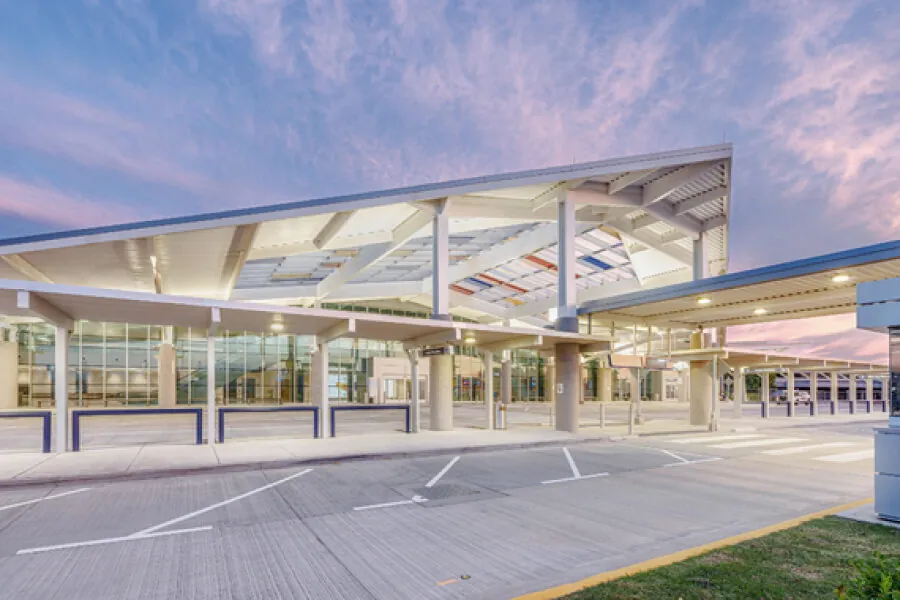4 Trends Driving Airport Terminal Design

Airport terminal design is often a great indicator of societal happenings and tendencies. Think back to the events of 9/11, this moment changed the landscape of airports forever. In fact, 9/11 is still driving terminal design concepts today, more than 20 years later. And with the recent COVID-19 pandemic, creating a safer passenger experience plays a huge factor in the future of terminal design.
Download Now: Terminal Design Trends Lookbook
Airports are economic investments for their communities; designed and built to last for years to come. While new and updated terminals must reflect the needs of today, they also must prepare to meet the needs of the future. Here is a look into four trends driving airport terminal design today.
Enhanced Flexibility That Allows for Future Growth
Shifting towards flexible design allows airports to accommodate for future changes while maintaining a hassle-free passenger journey. Air transportation is in high demand and is projected to continue growth by an average of 4.3% per year over the next 20 years. While models can project future growth, we can’t plan for unforeseen events and changes that could also affect air travel. So, airports must be able to adapt and shift for both projected growth and unforeseen circumstances.
The Eugene Regional Airport Master Plan is a great example of preparing for future growth. This new master plan established a vision for development beyond the typical 20-year planning horizon and gave guideposts to help the airport move forward in the years to come.
Embracing Touchless Technology
While touchless technology was making waves throughout airports before 2020, the COVID-19 pandemic pushed the idea further. Many of the technological advancements in airports today revolve around processing passengers as well as health and security advancements.
With the use of biometric technologies, like digital identity and facial recognition, there’s often no longer a need to hand a security agent your passport. With this technology, you simply stand in front of a camera, and through a scan, the security agent will be able to view all your identifying information and travel history. The use of biometric technologies is currently being evaluated by the Transportation Security Administration (TSA) to gauge their operational effectiveness and security efficiency.
Beyond biometrics, there’s also an increase in digital services. For the most part paper boarding passes are a thing of the past as most passengers now use their mobile phones as their tickets. Passengers are also using their phones to stay updated on their flights’ status, shop duty-free, order from restaurants and more.
Passenger Amenities
Airports are starting to enhance the passenger experience by focusing on improvements in passenger amenities. Some enhancements we’re starting to see in terminals are minor, like service animal relief areas and nursing mothers’ rooms, while others are more significant such as sensory rooms and connections with the outdoors.
In partnership with Hartsfield-Jackson Atlanta International Airport and The Arc, Delta launched a multisensory room in 2016. This room provides a calm, supportive environment for nervous passengers and passengers that are on the autism spectrum. Delta has also developed one of these multisensory rooms at New York-LaGuardia International Airport.
Airports are also creating connections with the outdoors, some through glass windows that showcase the landscape and others by providing spaces where passengers can step outside. The San Luis Obispo County Regional Airport attempts to blur the lines between indoor and outdoor spaces with the extensive use of glass to showcase the views of the local mountains and vineyards. The terminal also features a unique exterior courtyard connector between the ticketing building and holdrooms.
Reflecting Community Culture in Design
Airports today are a lot like the grand train stations of yesterday, for passengers they’re the first and last impression of the community so they must be indicative of the community and its culture.
Placemaking is driving the planning, design and management of airports of all sizes. Placemaking is the concept of finding unique qualities within a community that speak to the culture, environment and people that live there. The idea is that the minute you walk off the jet bridge and into the airport, the airport itself will be an extension of the community.
While you’ll still see the major chains like Starbucks, many airports are incorporating local concessions and products throughout terminals. This allows passengers to experience local culture through their food choices and while browsing shops as they wait for their flight. The use of natural materials in design and featuring music and murals from local artists are other ways to showcase a community’s unique culture.
For these elements to feel authentic, rigorous research into the community and community engagement is imperative.
The design behind the award-winning terminal at Lafayette Regional Airport was driven by extensive research including visits to museums, cultural centers and conversations with community stakeholders. Through metaphors such as the structural-steel canopy, which represents a Lafayette landmark – the St. John Cathedral Oak; the colors in the skylight reflect the Arcadian flag, at the terminal entrance and inspirations from nature like the featured bayou scene from the local Atchafalaya Basin, the design authentically embraced the distinctive characteristics of Lafayette.
Guided by the trends explored, terminal designs of today are geared toward striking a balance between timeless community characteristics and the needs of the future all while creating a seamless experience from start to finish for passengers.
If you’re curious about how your next terminal or upgrade can incorporate these guiding trends, reach out to our aviation experts. For more than 80 years, our integrated team has successfully met all challenges regardless of the project’s size, location or nature. Let’s create the future of aviation together.




